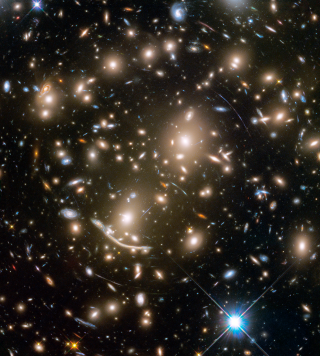Bibcode
Girardi, M.; Zarattini, S.; Boschin, W.; Nonino, M.; Bartalucci, I.; Mercurio, A.; Nocerino, N.; Rosati, P.
Referencia bibliográfica
Astronomy and Astrophysics
Fecha de publicación:
3
2023
Revista
Número de citas
4
Número de citas referidas
4
Descripción
Context. In the accretion-driven growth scenario, part of the intracluster light is formed in the group environment.
Aims: We report the serendipitous discovery of a group of galaxies with signs of diffuse light in the foreground of the known galaxy cluster MACS J0329−0211 at z ∼ 0.45.
Methods: Our investigation began with the detection of diffuse light streams around a pair of bright galaxies in the southeastern region of a Suprime-Cam image of the galaxy cluster MACS J0329-0211. Our analysis is based on the extended CLASH-VLT redshift catalog and on new spectroscopic data obtained ad hoc with the Italian Telescopio Nazionale Galileo. We use the density reconstruction method to analyze the redshift distribution of the galaxies in the region around the galaxy pair. We also use available photometric and X-ray data to better characterize the properties of the group.
Results: Thanks to the large amount of redshift data collected in this region, we have been able to discover the existence of a group of galaxies, here called GrG J0330−0218, which is associated with the pair of galaxies. These are the two brightest group galaxies (BGG1 and BGG2). We extracted 41 group members from the redshift catalog and estimate a mean redshift z = 0.1537 and a line-of-sight velocity dispersion σv ∼ 370 km s−1. In the phase-space diagram, the distribution of the galaxies of GrG J0330-0218 follows the characteristic trumpet-shaped pattern, which is related to the escape velocity of galaxy clusters, suggesting that the group is a virialized structure. Under this assumption, the mass of the group is M200 ∼ 6 × 1013 M⊙. We also measured a mass-to-light ratio of ∼130 M⊙/L⊙ and a luminosity fraction of diffuse light of ∼20% within 0.5 R200.
Conclusions: We conjecture that galaxy pairs that are surrounded by diffuse light, probably due to tidal interactions, can serve as signposts for groups.
Aims: We report the serendipitous discovery of a group of galaxies with signs of diffuse light in the foreground of the known galaxy cluster MACS J0329−0211 at z ∼ 0.45.
Methods: Our investigation began with the detection of diffuse light streams around a pair of bright galaxies in the southeastern region of a Suprime-Cam image of the galaxy cluster MACS J0329-0211. Our analysis is based on the extended CLASH-VLT redshift catalog and on new spectroscopic data obtained ad hoc with the Italian Telescopio Nazionale Galileo. We use the density reconstruction method to analyze the redshift distribution of the galaxies in the region around the galaxy pair. We also use available photometric and X-ray data to better characterize the properties of the group.
Results: Thanks to the large amount of redshift data collected in this region, we have been able to discover the existence of a group of galaxies, here called GrG J0330−0218, which is associated with the pair of galaxies. These are the two brightest group galaxies (BGG1 and BGG2). We extracted 41 group members from the redshift catalog and estimate a mean redshift z = 0.1537 and a line-of-sight velocity dispersion σv ∼ 370 km s−1. In the phase-space diagram, the distribution of the galaxies of GrG J0330-0218 follows the characteristic trumpet-shaped pattern, which is related to the escape velocity of galaxy clusters, suggesting that the group is a virialized structure. Under this assumption, the mass of the group is M200 ∼ 6 × 1013 M⊙. We also measured a mass-to-light ratio of ∼130 M⊙/L⊙ and a luminosity fraction of diffuse light of ∼20% within 0.5 R200.
Conclusions: We conjecture that galaxy pairs that are surrounded by diffuse light, probably due to tidal interactions, can serve as signposts for groups.
Full Table 1 is only available at the CDS via anonymous ftp to cdsarc.cds.unistra.fr (ftp://130.79.128.5) or via https://cdsarc.cds.unistra.fr/viz-bin/cat/J/A+A/671/A83
Proyectos relacionados

Evolución de Galaxias en Cúmulos
Las estructuras en el Universo, a todas las escalas de masa, se han formado de una forma jerárquica y principalmente producidas por fusiones de galaxias. Sin embargo, esta formación jerárquica de las galaxias está modulada por el entorno en el cual se crean y evolucionan. Mientras que las galaxias de campo presentan una evolución pasiva, los
Jairo
Méndez Abreu